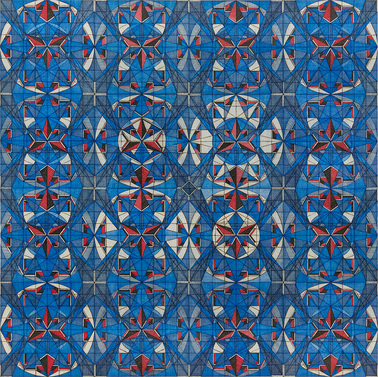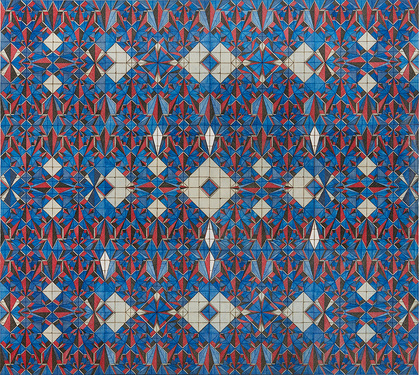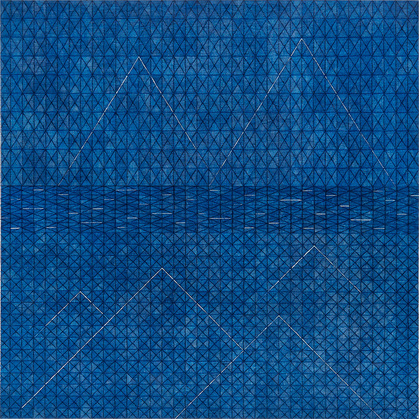-
From Current Issue
-
- Editor’s Letter Fire in the Heart
- Reviews I Gusti Ayu Kadek Murniasih
- Reviews 11th Seoul Mediacity Biennale: “One Escape at a Time”
- Dispatch Networked China
- One on One Monira Al Qadiri on Yukio Mishima
- Essays The rise of independent art spaces in pandemic-era Shanghai
- Features Tuan Andrew Nguyen
- Table of Contents
- Web Exclusives
- Archive
- Subscribe

R
E
V N
E
X
T
Installation view of LI WENGUANG’s “Palingraphia” at Hive Center for Contemporary Art, Shenzhen, 2018. All images courtesy Hive Center for Contemporary Art.
Despite the somewhat obtuse title to this exhibition, coming from the medical term denoting a pathological repetition of words or phrases, Li Wenguang’s new work continues the artist’s signature motifs of hard-edge geometric abstraction that has been at the core of his work since 2012. Working with rudimentary materials—ballpoint pens, oil and acrylic paint, resin, and rice paper collaged to canvas—Li creates dense and complex surfaces, the result of incremental mark-making and arduous repetition, executed by hand, to create patterns and discover new forms dictated by logic and symmetry.
While somewhat limited by the standard shades of ballpoint ink (predominately blue, black and red), Li has managed to overcome his restricted palette by producing dazzling kaleidoscopic compositions. The kaleidoscope, invented by Scottish scientist Sir David Brewster in 1816, along with other curious inventions used to demonstrate scientific theories, was referred to as a “philosophical toy” and became parlor entertainment by the mid 19th century. I think about Brewster’s philosophical toy when looking at Li Wenguang’s work, specifically in the
new paintings simply numbered 11, 12 and 13 (all works 2018), for their dynamic animated precision and swirling effect. All of Li’s paintings are enhanced by the use of clear resin overlaying their surfaces—for archival purposes and to extend the longevity of the color—with the effect that we could be looking at finely woven textiles, glazed ceramic tiles, or intricate designs for stained glass windows. These diverse or alternative material possibilities, too, might also be a worthwhile direction for this artist to pursue.
The show also featured Li’s recent “Blue” series, which he began
in 2017. Thoughtfully isolated and installed in a separate gallery space of their own, these works are more subdued and meditative. Dominated by their all-over use of a single color, and executed with the same degree of labor-intensive repetition and mark-making, they demand a closer reading. Landscapes and weather conditions (mountains, rain, sleet, a vast flatland as if viewed in aerial perspective), and the movement of water appear in Boundary River, Before the Rain, and Study on Sleet. While suggestive of landscape, or offering the viewer a glimmer of real-world reference points, these works pale in comparison to Li’s complex, multi-colored pattern works, which immediately engage the eye, absorbing the viewer in startling detail and pictorial rhythm, whereas the “Blue” series feels somewhat like monotonous toiling. Perhaps the most successful work in this series is the large painting Li Bai, a tribute to the Tang dynasty poet who is a source of much cultural and historical pride. The painting feels as if we are looking at a pixelated night sky, a clear, deep blue evening, with one bright and distant star in an otherwise empty heaven. It is in the simplicity and restraint that the poetry of this work shines through.
A curious departure from Li’s exacting style occurs in Potted Plant with Both Sides Under the Sun, in which Li begins to loosen up and relax. The pair of potted flowering plants are diagrammatic, like studies in architecture rather than botany, while, at the same time, reveling in a kind of crudeness, welcoming inaccuracy. The trompe l’oeil of tarnished grids, which serve as the work’s understructure, feels fresco-like, allowing for a distressed appearance of age. Two carefully rendered mandala shapes drift off to the right and to the lower center of the work, and seem like casual studies or quick thoughts within the work itself. The potted plant motif isn’t new to Li’s work (it’s been introduced in earlier works since 2014), but this painting begins to feel like a large and detailed page torn directly from the artist’s sketchbook, bringing a refreshing and intimate read on further possibilities for Li’s ongoing project.
Arthur Solway is the Shanghai desk editor of ArtAsiaPacific.
Li Wenguang’s “Palingraphia” is on view at the Hive Center for Contemporary Art, Shenzhen, until July 28, 2018.
To read more of ArtAsiaPacific’s articles, visit our Digital Library.







